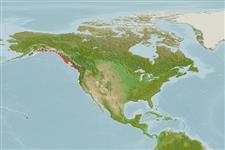>
Perciformes/Cottoidei (Sculpins) >
Cottidae (Sculpins)
Etymology: Asemichthys: Greek, asemos, -os, -on = unknown, confused + Greek, ichthys = fish (Ref. 45335); taylori: Named after Reverend G.W. Taylor, Curator and first Director of former Biological Board of Canada's (Pacific) Biological Station at Nanaimo (Ref. 6885).
More on author: Gilbert.
Environment: milieu / climate zone / depth range / distribution range
Ökologie
seewasser demersal; tiefenbereich 5 - 50 m (Ref. 43939), usually 5 - 18 m (Ref. 43939). Temperate
Northeast Pacific: southeastern Alaska northern Washington as San Juan Islands.
Size / Gewicht / Alter
Maturity: Lm ? range ? - ? cm
Max length : 7.6 cm TL Männchen/unbestimmt; (Ref. 2850)
Rückenflossenstacheln (insgesamt): 10 - 11; Rückenflossenweichstrahlen (insgesamt): 14-17; Afterflossenstacheln 0; Afterflossenweichstrahlen: 13 - 17; Wirbelzahl: 33 - 35. Olive brown dorsally, lighter ventrally; 4 dark saddles; brown bars on pectoral and caudal fins (Ref. 43939).
Found on sand and shell bottoms near rocky outcrops (Ref. 43939).
Life cycle and mating behavior
Geschlechtsreife | Fortpflanzung | Ablaichen | Eier | Fecundity | Larven
Mecklenburg, C.W., T.A. Mecklenburg and L.K. Thorsteinson, 2002. Fishes of Alaska. American Fisheries Society, Bethesda, Maryland. xxxvii +1037 p. (Ref. 43939)
IUCN Rote Liste Status (Ref. 130435)
Bedrohung für Menschen
Harmless
Nutzung durch Menschen
Mehr Information
NamenSynonymeMetabolismusRäuberÖkotoxikologieFortpflanzungGeschlechtsreifeAblaichenSpawning aggregationFecundityEierEientwicklung
ReferenzenAquakulturAquakultur ProfilZuchtlinienGenetikElectrophoresesVererbbarkeitKrankheitenVerarbeitungNutrientsMass conversion
PartnerBilderStamps, Coins Misc.LauteCiguateraGeschwindigkeitSchwimmstilKiemenoberflächeOtolithsGehirngrößeSehfähigkeit
Tools
Zusatzinformationen
Download XML
Internet Quellen
Estimates based on models
Preferred temperature (Ref.
123201): 7.2 - 11.7, mean 9.5 °C (based on 184 cells).
Phylogenetic diversity index (Ref.
82804): PD
50 = 1.0000 [Uniqueness, from 0.5 = low to 2.0 = high].
Bayesian length-weight: a=0.00676 (0.00300 - 0.01523), b=3.17 (2.98 - 3.36), in cm total length, based on LWR estimates for this (Sub)family-body shape (Ref.
93245).
Trophic level (Ref.
69278): 3.3 ±0.5 se; based on size and trophs of closest relatives
Widerstandsfähigkeit (Ref.
120179): hoch, Verdopplung der Population dauert weniger als 15 Monate. (Preliminary K or Fecundity.).
Fishing Vulnerability (Ref.
59153): Low vulnerability (10 of 100).
